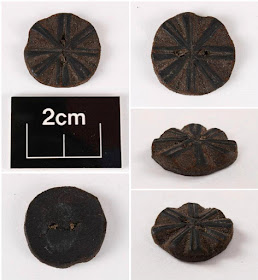Illustrations, engravings, and paintings can only take us so far in the examination of common sailors' clothing. As I have often said before, art has its limitations. Most artists on this website were not sailors, and so their images are often exaggerated caricatures of what they saw of sailors ashore. Colorists could impose their own interpretations on engravings, adding stripes where the artist intended none, or changing the buttons to be white metal, yellow metal, or cloth covered.
Other sources can fill in the gaps. Archaeological excavations of ships can reveal items that would otherwise go completely unnoticed in a straight examination of primary source artwork. Take this interesting example:
Steve Rayner and Matthew Brenckle, in comparing the findings from four separate vessels stretched out over thirty years turned up a single button style present at every one. All of the following photos, save one, were provided by Steve Rayner.
From the 74 gun Invincible wrecked off the Isle of Wight in 1758:
 |
| Button, INV.135, Invincible collection, The Historic Dockyards Chatham |
The naval sloop Boscawen abandoned around 1767 on Lake Champlain:
 |
| Personal Possession from the H.M.S. Boscawen, Gail Erwin, Texas A&M, 1994, page 174 |
The American privateer Defence burned and sunk in Stockton Springs, modern day state of Maine in 1779:
 |
| The Defence: Life at Sea as Reflected in an Archaeological Assemblage from and Eighteenth Century Privateer, Shelley Owen Smith, University of Pennsylvania, 1986, page 115 |
And the merchantman General Carleton, sunk in a storm off the Polish coast in 1785:
 |
| Detail of General Carleton Waistcoat, courtesy of Matthew Brenckle |
The similarities are immediately obvious. These small leather buttons are present on a privateer, two warships, and a merchantman recovered in the English Channel, the Northeastern coast of the United States, the Polish coast, and one of the Great Lakes in North America. Despite being spread out over nearly thirty years, these star pattern leather buttons are present.
It appears that these buttons were either carved or stamped, and there is evidence for both. The process might have been a fairly common one. In the newspaper clipping below, provided by Matthew Brenckle, an admiral is said to have neglected his duty, having 'been too much in the state room making leather buttons for his son's jacket.'
 |
| London Evening Post, September 29, 1770 - October 2, 1770 |

No comments:
Post a Comment